The Ultimate Neolith Countertops
Pros & Cons Review
Neolith countertops are a surface material known as “ultra-compact surfaces” or "sintered stone". Made from all-natural materials, Neolith countertops are making a splash among builders and renovators, due to their excellent performance when compared to other popular countertop materials.
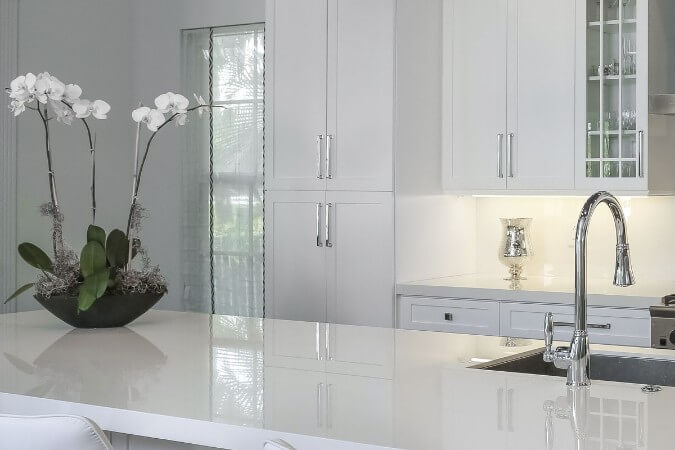 Polished Neolith countertops, Pure White
Polished Neolith countertops, Pure WhiteNeolith countertop material is attractive, durable, and packed with features you’ll love when remodeling or upgrading to new kitchen countertops. But how does it compare to granite or quartz? Let’s find out...
On This Page
Neolith is a product of a Spanish company called TheSize, which was started in 2009 by professionals from the natural stone industry. TheSize began producing the Neolith ultra-compact surface in 2010.
What Are Neolith Countertops Made Of?
Like its competitor Dekton, Neolith countertop material is made with 100% natural materials. Granite compounds, natural oxides, glass, and silica minerals are combined through a process of extreme heat, pressing, and sintering into one of the most resilient surfaces available.
You may see the terms "Neolith porcelain countertops" or "Neolith stone". But these are incorrect. Neolith is made with the elements of stone, but it's not a natural stone material. It's man-made. And Neolith is more durable than porcelain counters, although the two share some similarities.
The raw materials used to make Neolith countertops are similar to those used to make glass, porcelain, and quartz countertops. However, a specific combination of materials and unique production process give Neolith a superior strength, hardness, and durability:
- A high-pressure manufacturing process makes the sintered stone slab very dense and non-porous
- Neolith does not need to be sealed, and it is effectively stain-proof
- Neolith countertops can withstand high temperatures from hot pans without scorching or cracking from thermal shock
- Glass and silica minerals provide chemical stability and resistance to damage from chemicals and cleaners
- Resistance to freezing weather makes Neolith an ideal choice for outdoor kitchen countertops.
Neolith Countertop Pros and Cons
As with all types of kitchen countertops, there are many things to love about sintered stone countertops; Neolith also has one or two disadvantages which we will address below.
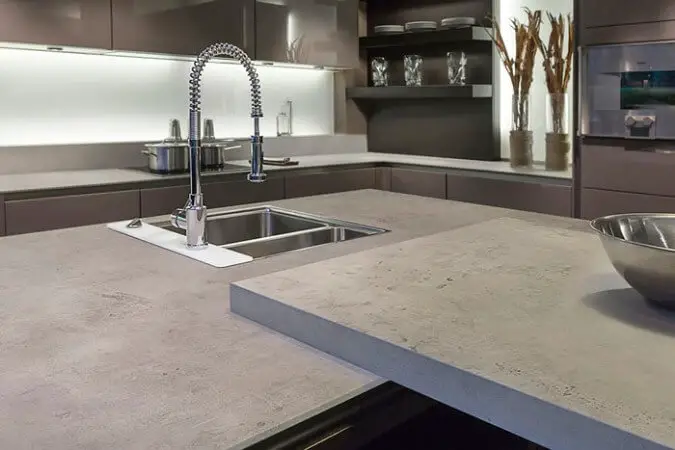 Contemporary, concrete-look Neolith countertops
Contemporary, concrete-look Neolith countertopsNeolith Countertops: Advantages
- Neolith is a zero-waste, carbon-neutral countertop material.
- Affordable when compared to other popular countertop materials.
- Can be used for interior walls and backsplash, even behind a stove.
- Sustainable, eco-friendly, resin-free, and made up of 52% recycled materials. The new Essentials collection is made of 90% recycled materials.
- Non-porous; Neolith won’t stain, even if you don’t wipe up coffee or wine spills right away.
- Ultra-hygienic and easily disinfected. Now made with NeolEAT anti-bacteria technology baked in.
- Acid-resistant: Neolith will not etch like marble or suffer chemical damage like quartz.
- Heat-resistant, so hot pots and pans can be set directly on the surface.
- Able to withstand temperature fluctuations without cracking, so it can be installed outdoors.
- Fade-resistant: UV rays from sunlight will not fade the color, so Neolith is suitable for outdoor kitchen countertops.
- Scratch-resistant (unless it has a highly “polished” finish).
- Extensive selection of colors and patterns, including options that resemble Calacatta and Carrara marble.
- Colors and patterns are full thickness (unlike porcelain).
- Easy-to-clean with water and mild detergents.
- Fewer seams needed, as Neolith is available in very large-format sheets.
Neolith countertops offer several advantages, but homeowners love the availability of extra-large slabs which are ideal for today's large kitchens. Non-porous sintered stone can also provide the look of natural marble with a durability that exceeds granite. Neolith is also eco-friendly and can incorporate recycled materials. In fact, there are many reasons homeowners choose Neolith countertops:
Neolith Countertops: Disadvantages
Because of its unique durability, Neolith countertop material has few disadvantages. The main issue faced by contractors and homeowners is that Neolith must be carefully handled during transport and installation. Because it's a thinner material, it is more prone to cracking or chipping than a granite or quartz. However, once installed on a substrate it's extremely durable. Before selecting Neolith countertops it's important to consider the following:
- Depending on where you live, it may be difficult to find skilled countertop fabricators willing to work with Neolith.
- Colors may not match from one slab to the next, as Neolith shades can vary with the dye lot.
- Countertop overhangs such as bar tops are limited to only 6 inches, unless additional support is added.
- Neolith counters might be scratched by ceramic knives, but nothing else.
- A highly polished Neolith finish may be susceptible to abrasion.
- If they suffer a heavy impact, sintered stone countertops may chip more easily than other materials. However, stone and quartz materials can also chip.
Neolith Countertops Colors, Edges & Finishes
Neolith Colors:
Neolith is available in more than 30 colors, ranging from white to gray, black, and brown.
Many homeowners want countertops that look like marble - but without the maintenance of marble. It’s no surprise that the most popular Neolith colors are amazingly realistic marble look-a-likes:
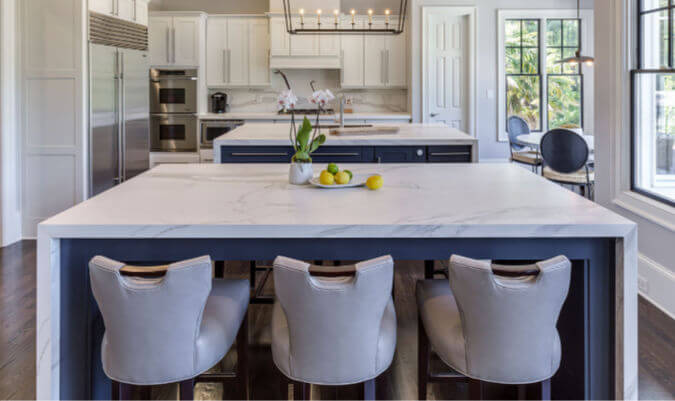 Neolith Estatuario countertops on a kitchen island
Neolith Estatuario countertops on a kitchen islandNote: Because Neolith is man-made, color shades can vary depending on the manufacturer’s dye lot. Before you update a kitchen or bathroom, be sure to buy all the Neolith sintered stone slabs you need in a single purchase, and confirm they are from the same dye lot.
Video: Neolith Kitchen Design Ideas
Neolith Finishes:
Neolith offers a range of sintered stone finishes to suit any kitchen design style, for the home or for commercial use. Neolith countertop finishes include:
- Natural Honed - matte, honed finish as on natural stone
- Satin - completely matte finish that is highly-resistant
- Silk - matte with a subtle shine
- Ultrasoft - matte but with extra softness and depth of color
- Slate - appears to have thin layers and texture of natural slate
- Steel Touch - metallic look with soft reflections
- La Boheme - warm, soft feel of wood
- River washed - slight rough texture
- Anti-Slip - for flooring and wet applications
- Polished - glossy, reflective, excellent color depth
Note: the “polished” finish is far less resistant to scratches and abrasion. Knives and abrasives cleaners can scratch or dull a polished Neolith finish. And ceramic knives can scratch all finish types.
Some of the finishes above are only available in specific Neolith color collections.
Neolith Edges:
Even though Neolith is thinner than natural stone countertops, there are a variety of edge profiles to choose from. Installers can use a substrate to create thicker edge profiles.
- Minimalist edging is a contemporary style that features the thin look of the Neolith material. Edges are either Eased or Bullnose style (see below).
- Mitered edge uses a short apron to mimic the thicker edges of granite and marble.
- Waterfall edge continues the countertop surface down to the floor for a luxury look; this requires building a substrate.
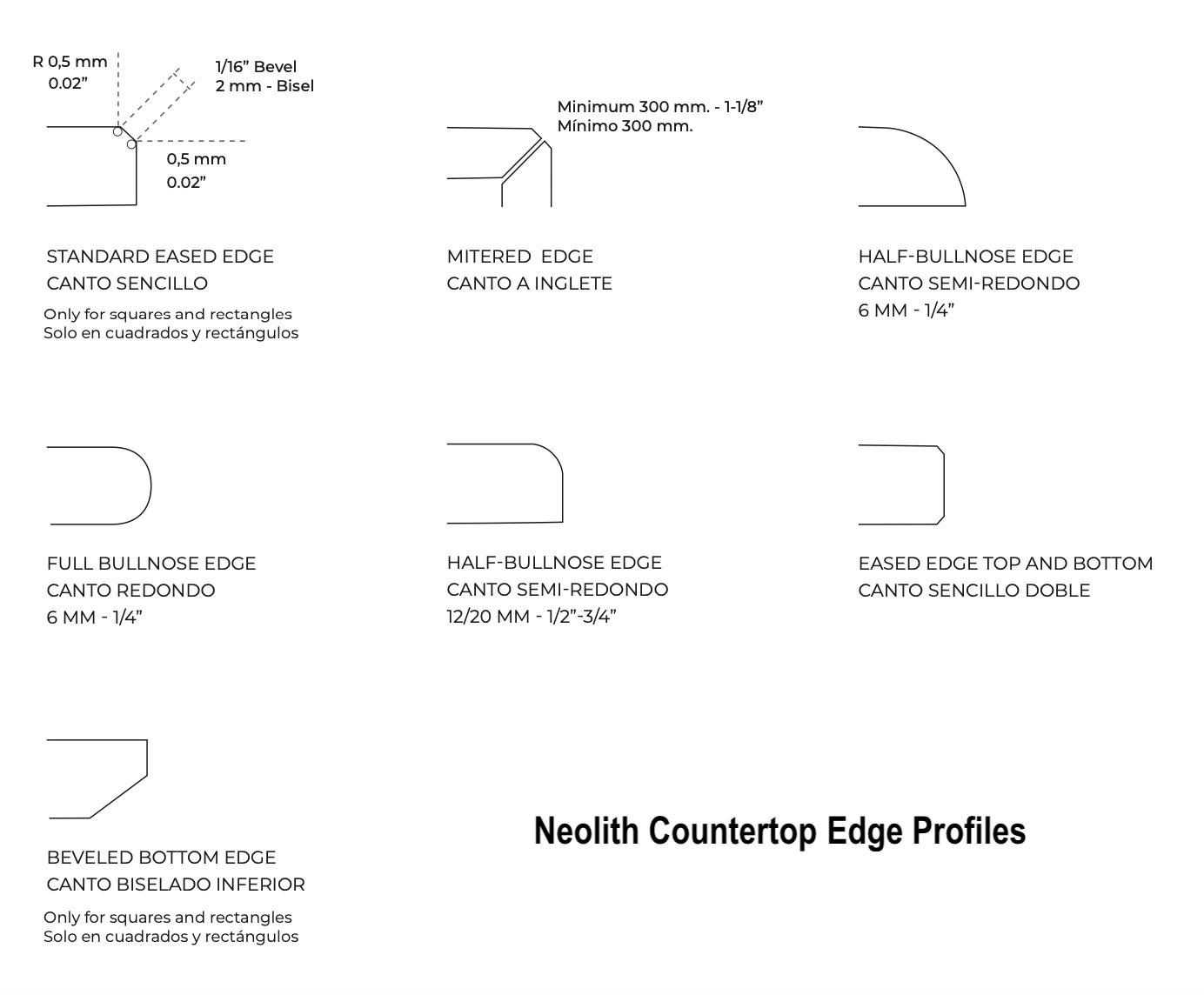
Neolith Countertop Thickness
In addition to a choice of colors and edge profiles, Neolith slabs are available in different sizes and thicknesses for various applications:
- 3mm (⅛”) for interior wall cladding
- 6mm (¼”) for interior flooring or exterior walls
- 12mm (½”) for countertops and exterior flooring
- 20mm (¾”) for countertops and exterior pavers
Slab sizes range from 2.5 ft. x 2.5 ft (750mm x 750mm) to 10 ft. x 5 ft. (3200mm x 1500mm) and can be cut to any size or shape.
The large-format slabs reduce the required number of seams, making it easy to cover large kitchen islands or long countertop runs while maintaining a cohesive pattern.
Neolith Care and Cleaning
Neolith countertop material is easy to care for and doesn’t require special cleaning products.
Recommended cleaners:
Neolith is easy to maintain - hot water is just fine for quick cleanups, with a spritz of countertop cleaner on soiled spots.
Puracy cleaner is an excellent choice for Neolith, or use a quality quartz and granite cleaner for a streak-free shine.
Avoid using dish soap as a regular cleaner. Many soaps and detergents contain waxes that will leave a dingy residue or film on the surface over time.
It’s important to note a few things though…
- Immediately after installation, a deep cleaning with hot water may be necessary to remove cement or joint compound residue.
- Clean dry or encrusted food on the countertop by soaking it with hot water and then wiping it with a damp cloth and your chosen surface cleaner.
- Avoid abrasive scrubbers and cleaners on the “polished” finish. Neolith surfaces are very scratch-resistant and essentially scratch-proof - except for the “polished” finish.
- Do not use acidic cleaners on a newly installed Neolith countertop as acids may damage the glue used for joints and seams.
- Do not use ceramic knives on Neolith surfaces. Ceramic knives are the kryptonite of sintered stone (ultra-compact surfaces) and will scratch all finish types.
Neolith Countertops Cost
Costs for Neolith countertop material alone began at $10 to $30 per square foot a few years ago; today it runs $24 to $40 per sq. ft., which means that Neolith prices are increasing.
The total installed cost of Neolith is $60 - $105/sq. ft. which is similar to mid-to-high-end granite countertops as well as some quartz countertops.
Depending on the pattern, Neolith may be cheaper than quartz or granite, but on average this is not the case. (Although quartz has increased in price now that tariffs have been imposed on quartz slabs from China).
Granite prices have also dropped over the last 10 years, with many granite colors available for $45-$65 per square foot.
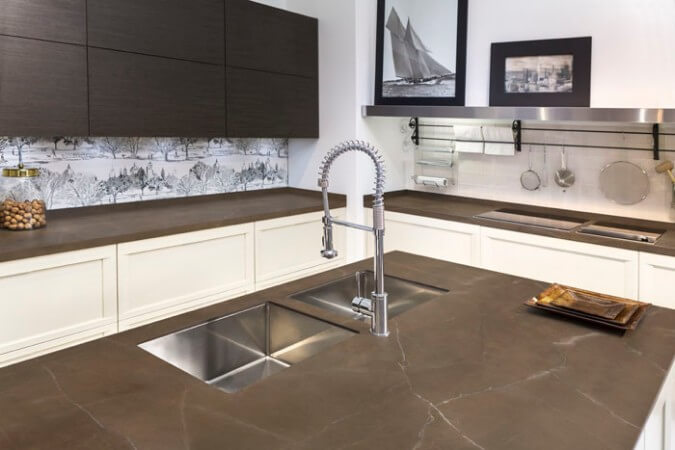 Neolith Iron Moss kitchen island
Neolith Iron Moss kitchen islandTo calculate the exact cost for a Neolith countertop project, you must first specify what color, slab size, and thickness you need.
The following installation variables have a significant impact on the final price:
- Number of cutouts for sinks and a cooktop
- Edge treatment
- Finish type
- Number of seams
- Complexity of the installation
You may be able to cut the cost of your new Neolith countertops by choosing a thin 6mm slab (normally for flooring or wall cladding) and installing it over the top of an existing countertop. This is something you’d need to discuss with an experienced Neolith installer, as thicker 12mm slabs are recommended for kitchen countertops. While you'll save money on the overall project cost, thinner slabs are more susceptible to damage like cracking and chipping.
Neolith Countertop Installation
As noted in the pros and cons above, Neolith and all ultra-compact sintered surfaces are particularly vulnerable to damage prior to installation.
Once sintered stone countertops are installed, they are very stable and durable. However, this countertop material is thinner than natural stone, which makes it challenging to transport, cut, or move around without cracking or splintering the slab or chipping the edges.
Some argue that because Neolith is so lightweight it is easier to cut and install. However, because it's so hard and thin, it's brittle when unsupported so it presents some unique installation issues.
Of course granite and quartz sometimes crack during installation too, but Neolith and ultra-compact surfaces must be carefully handled to avoid damage. Because of this, many fabricators refuse to install Neolith or any other ultra-compact surface brand. This is one reason why Neolith is not widely available.
On the plus side, the thin Neolith slab can be installed on top of many existing countertops. This can save customers money by not having to tear out old countertops.
Where To Buy Neolith
Neolith distributors or fabricators are not nearly as plentiful as those for granite or quartz. So, you may have some difficulty finding a supplier near where you live.
In large metropolitan areas, check with stone warehouses or countertop fabricators to find a local Neolith dealer. Or use this Where to buy Neolith search tool to find distributors near you.
Neolith vs. Quartz Countertops
While quartz countertops are made by a similar manufacturing process, Neolith sintered stone countertops have several advantages over quartz. Neolith and all ultra-compact surfaces were designed to improve upon the weaknesses of quartz.
- Neolith countertops are cured to incredibly high temperatures (2191°F) and cannot be burnt or scorched by hot pots and pans.
- Quartz can withstand heat of approximately 300°F, so it can be scorched by hot pans or cracked by heat shock.
- Quartz is highly susceptible to UV damage, causing the color to fade; thus quartz cannot is not suitable as an outdoor countertop.
- Neolith colors do not fade so the material is ideal for outdoor countertops.
- Quartz countertops are non-porous and resistant to acids and staining, but can be discolored permanently by several different types of household cleaners.
- Neolith is also non-porous and stain-resistant but is much more resistant to chemical damage and will not be discolored by cleaners.
- Quartz countertops have far more color choices than Neolith.
Neolith vs. Granite Countertops
Granite countertops are the “gold standard” of performance by which all other countertop materials are measured.
Even though granite is not without its own issues, most man-made countertops are trying to create a surface that performs as well or better than granite white providing a unique feature that granite does not have.
When comparing Neolith countertops vs. granite, Neolith holds up well.
- Granite has excellent heat and scratch resistance.
- Neolith is also highly heat and scratch-resistant (except for the “polished” finish which can be dulled by abrasives or scratched by knives).
- Granite will not be damaged by acidic foods, drinks, or chemicals, except by industrial-strength acids or repeated exposure.
- Neolith is also resistant to chemical etching or damage.
- Granite is porous and can be stained. Sealing is needed on most (but not all) granite colors.
- Neolith is non-porous, doesn’t stain and does not need sealing.
- Granite can crack under extreme temperature changes or heavy impact.
- Neolith may also crack with a heavy impact but is highly-resistant to cracking from temperature changes.
- Granite may develop small pits and can be chipped.
- Neolith will not pit, but it may chip especially on the edges.
- Granite has thousands of colors - Neolith has fewer than 100.
Choose Neolith Countertop Material For Performance
Neolith countertops are a revolutionary product that offers several advantages over other countertop materials. It has a few drawbacks, but every material has its own issues.
Neolith is very durable, heat-resistant, stain-resistant and scratch-resistant (as long as ceramic knives and certain abrasives are avoided). While it does not crack easily, dropping heavy objects on the surface could cause a crack or chip.
Neolith countertop colors are limited, but they're available in a modern palette with several finish types and edge style options. Clients can achieve the look of natural marble in a far more durable material. The large-format slabs allow for fewer seams and a more cohesive pattern overall.
Neolith easy to clean with common cleaning products, but you cannot use abrasive cleaners on the polished finish. All other finish types can be scoured.
A skilled fabricator with experience installing Neolith countertops is a must, since sintered stone is more fragile when cutting and installing than other materials.
All things considered, the Neolith ultra-compact surface is competitive on price and durability to granite and quartz, offering a high performance surface for your kitchen countertops.
All images courtesy Neolith.com.
FAQs
How much does Neolith cost?
How much does Neolith cost?
Neolith countertops are priced between $60 and $105 per square foot installed.
Does Neolith chip easily?
Does Neolith chip easily?
Neolith does not crack easily, but dropping heavy objects on the surface could cause a crack or chip.
Does Neolith need to be sealed?
Does Neolith need to be sealed?
Neolith is non-porous and does not need a sealant, unlike natural stone.
Is Neolith porcelain?
Is Neolith porcelain?
Neolith is a sintered stone, which is similar to porcelain but even more durable.
Is Neolith better than quartz?
Is Neolith better than quartz?
Neolith is substantially more stain-and-heat resistant than quartz, so it's suitable for use as a stove back. Setting a hot pan on quartz can damage it, but Neolith can't be damaged by hot pots and pans.
Is Neolith cheaper than quartz?
Is Neolith cheaper than quartz?
Neolith is about the same price range as quartz, although it has a few styles that are less expensive. Cost depends on the style of each material.


